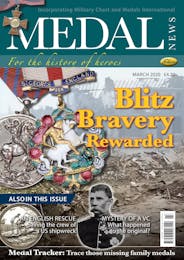
Then and now
ONE of the most fascinating things about medal collecting is, of course, the history behind them. We most likely wouldn’t be medal collectors if we didn’t have an interest in the past, but the news this month that the British Red Cross is going to stop issuing the Voluntary Medical Service Medal (MYB266) simply because they are closing down their Event First Aid Service (I’m guessing those wonderful people at fetes, concerts, festivals etc. that help those with sun stroke and drink stroke) and thus will have no more volunteers able to reach the 15 year milestone (how galling would it be to be just shy of that and now know that you’ll never make it?) has got me thinking. How many medals do we have in our collections that are actually still being awarded today? Obviously “modern” collectors will possess a number of medals one can still see on the chests of those still serving whereas those specialising in the Peninsular War would be hard pressed to find a gong on parade today that they recognise from one of their groups. But there must be quite a few medals that are being awarded today that have been around a while, mustn’t there?
Orders have spanned the centuries of course, and gallantry medals have been around for decades too—the Victoria Cross is an obvious example but you could, theoretically, still see a Distinguished Conduct Medal (instituted in 1854) worn today as well. It would have to be a historic award though, most likely on a veteran rather than a serving soldier as the DCM vanished in John Major’s overhaul of the Honours system 27 years ago. The Military Medal went the same way, as did the equivalents for the RAF and Navy/Marines but the Military Cross survived so that’s one we can count. It has been in existence since 1914 and is still awarded, albeit the criteria for the award are now different from what they were 106 years ago, not least the fact that enlisted men rather than just officers can win it. The Distinguished Flying Cross is another that’s still with us as is the Distinguished Service Cross—but what else? Obviously campaign medals aren’t generally awarded long after the campaign for which they were instituted is over (don’t get me started on retrospective campaign medals) so we aren’t likely to find too many of those appearing in both historic groups and being awarded to those serving now, the same goes for Coronation and Jubilee medals, but there are still one or two others that have stayed with us over the years. The most obvious of these are the Long Service and Good Conduct medals. The Army medal was introduced in 1830 and is still awarded today and the Navy medal was introduced a year later and it too is still being awarded. Yes the design has changed over the years and who cannot help but mourn the loss of the beautiful Georgian and Victorian reverses of the Army Medal, replaced in 1901 with simple words? The Navy equivalent actually went the other way, the early designs of the fouled anchor on the obverses and the name of the recipient on the reverse being replaced in 1848 with the monarch’s effigy and the splendid man of war that still graces the medal today. The RAF version of the medal was instituted in 1919 but its design has remained the same, it too is still awarded in the 21st century. The criteria for these medals has changed of course, and now even officers, who were once expected to serve for a long time and to conduct themselves impeccably can receive recognition!
Alongside the LS&GC is the Army Meritorious Service Medal—it too has a grand history. Instituted in 1845 it is still awarded in small numbers today and although the ribbon has changed to differentiate it from the Army LS&GC, the basic design remains as it was 175 years ago. The Naval and RAF equivalents came along just after WWI and both are still awarded as well. Service medals as a whole have a relatively “long life” as illustrated by such examples as the Royal Household Faithful Service Medals, around since 1872, and the Order of St John Service medal (now with a new Ultra Long Service award—see News & Views this month) which has been awarded regularly since 1898. Then, of course, you have those medals that belong to a family with history, even if they themselves are the latest addition to it—the Polar Medal is a case in point, it “only” dates back to 1904 but in fact has a history going back to the Arctic Medal in 1857.
It is, I think, easy to forget that medals aren’t just part of the past, they actually really do provide a link to it—someone being awarded an OBE today can trace the history of the award back 100+ years, a soldier earning his LS&GC can go back 190 and know he’s part of a proud tradition. I’m sure I’ve missed out many awards that have a long history and are still awarded today—do write in and tell me which ones I should have included in my little list. Which one would you choose as an example?









